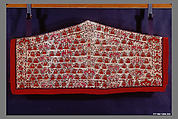Camel Trapping (Asmalyk)
Not on view
This type of embroidered camel trapping, called an asmalyk, was used in Turkoman wedding ceremonies, when the bride rides a richly adorned camel to her new home. The ornaments worn by the camel were woven by the bride, in order to demonstrate her sewing skills. These trappings were commonly woven in pile, although some were embroidered, as in this example, or created with felt appliqués. The most characteristic designs and colors are those that symbolize fertility, such as a lattice pattern called ahik, fashioned in red on a white ground. The main field of this five-sided panel consists of rows of hanging blossoms in red wool, punctuated by five columns of volute-shaped blossoms in pink silk. It is bordered with an alternating design of blossoms and quartered rosettes, with a surrounding band in blue and red flat weave.
Due to rights restrictions, this image cannot be enlarged, viewed at full screen, or downloaded.


